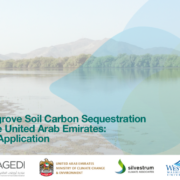First round of results of the UAE Mangroves Annual Carbon Sequestration Project
This report on the UAE Mangroves Annual Carbon Sequestration Project presents the results of our first two cores from Khor Kalba.
In this study, we quantify the rates at which carbon is removed from the atmosphere and stored in soils by mangroves of the United Arab Emirates through radiometric means: Lead-210 and Caesium-137. Such methods offer the most appropriate means to determine carbon sequestration rates for national inventories and coastal management planning.
We find at Khor Kalba, a rich and diverse marine ecological system, that the mangroves have been continuously sequestering soil carbon at a rate of 0.5 tons per hectare per year. This is in addition to the carbon stored each year in mangrove tree biomass. While this soil carbon sequestration value is about one third to one half of that found in very wet mangrove tropical areas of the world it is far higher than terrestrial soils of arid regions. Every ecosystem that sequesters carbon dioxide from the atmosphere is important in fighting climate change. Conserving and restoring blue carbon ecosystems of the United Arab Emirates contributes to tackling climate change and maintaining the rich ecology of the coasts and seas around the Arabian Peninsula.
With the successful attainment of carbon sequestration values from the Khor Kalba site, the project team is continuing to process the remaining 8 cores through 2020.
Download our full report here: UAE Mangroves Carbon Sequestration (60285 downloads )

